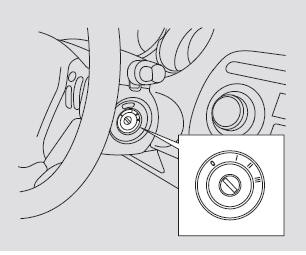Honda Fit: Ignition Switch

The ignition switch has four positions: LOCK (0), ACCESSORY (I), ON (II), and START (III).
LOCK (0) -
You can insert or remove the key only in this position.
To turn the key, push it in slightly. If your vehicle has an automatic transmission, the shift lever must also be in park.
If the front wheels are turned, the anti-theft lock may make it difficult to turn the key. Firmly turn the steering wheel to the left or right as you turn the key.
ACCESSORY (I) -
You can operate the audio system and the accessory power socket in this position.
ON (II) -
This is the normal key position when driving. Several of the indicators on the instrument panel come on as a test when you turn the ignition switch from the ACCESSORY (I) to the ON (II) position.
START (III) -
Use this position only to start the engine. The switch returns to the ON (II) position when you let go of the key.
You will hear a reminder beeper if you leave the key in the LOCK (0) or the ACCESSORY (I) position and open the driver’s door. Remove the key to turn off the beeper.
If your vehicle has an automatic transmission, the shift lever must be in Park before you can remove the key from the ignition switch.

Removing the key from the ignition switch while driving locks the steering. This can cause you to lose control of the vehicle.
Remove the key from the ignition switch only when parked.
See also:
Dust and Pollen Filter
On models with A/C
This filter removes the dust and pollen that is brought in fromthe outside through
the heating and cooling system.
Have your dealer replace the filter when this service is indic ...
Maintenance Safety
All service items not detailed in this section should be performed by a certified
technician or other qualified mechanic.
Important Safety Precautions
To eliminate potential hazards, read the inst ...
Disassembly
Compress the damper spring, then remove the nut (A) while holding the
damper shaft with a hex wrench (B). Do not compress the damper spring more
than necessary to remove the nut.
...
